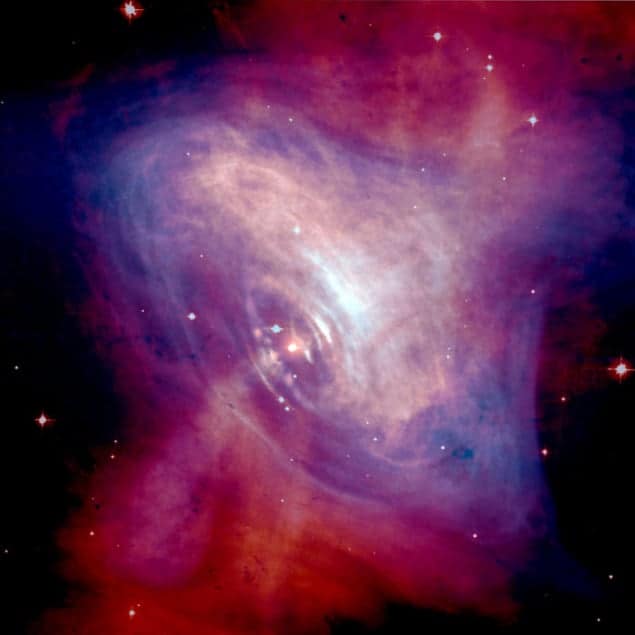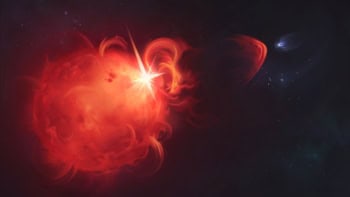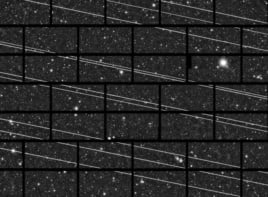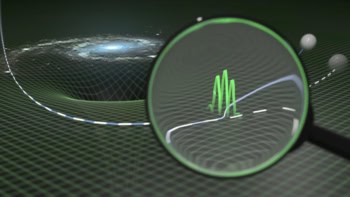
Pulsars are created when a star collapses to form a neutron star in which the magnetic moments of the neutrons are frozen in a particular direction – much like the atomic moments in a permanent magnetic. That is the claim of two physicists in Sweden, who believe that their theory can account for many of the unexplained properties of these astronomical oddities.
First discovered in 1967, pulsars are astronomical objects that emit radiation pulses with astonishing regularity. Astronomers believe pulsars are rapidly rotating neutron stars that have very large magnetic fields. Just like the Earth, the magnetic dipole moment of the star is believed to be offset from its rotational axis. Jets of radiation are emitted from the star along its magnetic poles. Because the star is rotating about a different axis, the jet sweeps round like a lighthouse beam that appears as a regular pulse if it happens to strike Earth.
Beyond this basic description, however, little is known about the physics of pulsars and how they formed. One important question is the origin of the magnetic field, which can range from about 104 to 1011 T. That is huge compared with the Sun’s magnetic field, which is about 100 µT. Furthermore, the regular nature of the pulses suggests that a pulsar’s magnetic field must be extremely stable. In contrast, the Sun’s magnetic field is notoriously unstable because it is generated by the rotation of the star’s plasma, which is prone to instabilities.
Nuclear force favours alignment
“There is no good explanation for how the magnetic field is generated,” explains Johan Hansson of Lulea University of Technology, who put forward this latest theory with colleague Anna Ponga. Hansson and Ponga suggest that the magnetic moments of all the neutrons in the star point in the same direction in a state of matter called a “neutromagnet”. This is similar to the alignment of atomic magnetic moments in a ferromagnetic material. The researchers point out that the nuclear force that binds protons and neutrons together in nuclei favours the alignment of spins – an effect that they say could be enhanced in neutron stars, where neutrons are packed even more tightly together.
Hansson and Ponga assumed that the energy gained by two neutrons by aligning their spins in the same direction is about 10% of the total nuclear binding energy of the pair. This gives a Curie temperature – below which all the neutrons in the star align to become a giant magnet – of about 1010 K.
Because neutron stars all seem to have about the same mass, the maximum magnetic field that could result is about 1012 T. This would occur when all the neutrons are aligned in the same direction. However, just like everyday magnets, it is possible that different regions of the star have domains of neutrons – with each domain pointing in a different direction. This would reduce the overall magnetic field and could explain why some neutron stars have much smaller magnetic fields. According to Hansson, this maximum value of the magnetic field provides astronomers with a simple way of falsifying the theory.
Moment is frozen in
Hansson told physicsworld.com that their model also explains the fixed misalignment between the magnetic moment and the rotational axis of a pulsar. “The orientation of the magnetic field is set by the direction of the star’s magnetic field at the moment it collapses to form the neutron star,” he explains. “The direction is then ‘frozen in’ by the nuclear force”.
However, not all astronomers are convinced. “I don’t claim that the current ‘understanding’ is complete or free of contradiction – the problem is very hard – but I believe that the concept presented in this paper is not nearly as good as the standard models,” says Michael Kramer of the University of Manchester in the UK.
The work is described in arXiv:1111.3434.



